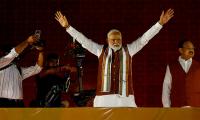DHAKA: Bangladeshi Prime Minister Sheikh Hasina’s 15-year rule ended on Monday as she fled more than a month of deadly protests and the military announced it would form an interim government.
She had sought to quell nationwide protests against her government since early July but she fled to India by helicopter, after a brutal day of unrest on Sunday in which nearly 100 people were killed. Bangladesh’s army chief General Wakeruz-Zaman said in a broadcast to the nation on state television that Hasina had resigned and the military would form a caretaker government.
“The country has suffered a lot, the economy has been hit, many people have been killed -- it is time to stop violence,” said General Zaman, dressed in military fatigues, shortly after jubilant crowds stormed and looted Hasina’s residence. He said he was “taking full responsibility” after PM Sheikh Hasina was ousted and fled. “I give you my word that all the injustices will be addressed,” the career infantry officer said, although it was not immediately clear if he would head the new government. He said he would talk to the president to form a caretaker government. Waker said he had held talks with the main opposition parties and civil society members but not Hasina’s Awami League. The mild-looking, bespectacled officer was appointed as chief of army staff only in June. Hasina had trusted him because he was a distant relative. The experienced soldier has served as a UN peacekeeper and has been in Hasina’s office. His father-in-law was army chief during the first of Hasina’s five terms as prime minister from 1996-2001.
Also, Bangladeshi President Mohammed Shahabuddin ordered the release of jailed former prime minister and key opposition leader Khaleda Zia. The president’s press team said in a statement that a meeting, led by Shahabuddin, had “decided unanimously to free Bangladesh Nationalist Party (BNP) Chairperson Begum Khaleda Zia immediately”.
Army chief General Wakeruz-Zaman, along with the head of the navy and airforce, and top leaders of several opposition parties including the BNP and Jamaat-e-Islami party, attended the meeting. “The meeting also decided to free all people who have been arrested during the student protests,” the statement added. Khaleda Zia, 78, is in poor health and confined to a hospital after she was sentenced to 17 years in prison for graft in 2018.
Earlier, at least 56 people were killed during violent unrest on Monday, police and doctors said, updating an earlier toll. At least 44 of the dead were brought to the Dhaka Medical College Hospital, an AFP correspondent said, reporting all had bullet wounds. Police said 11 others were killed elsewhere in the capital, and another in the port city of Chittagong.
Millions of Bangladeshis took to the streets across the South Asian country, many celebrating peacefully. Jubilant crowds waved flags, some dancing on top of a tank in the streets before thousands broke through the gates of Hasina’s official residence.
Bangladesh’s Channel 24 broadcast images of crowds running into the compound, waving to the camera as they celebrated, looting furniture and books while others relaxed on beds. Mobs also attacked the homes of Hasina’s close allies, witnesses told AFP. Others torched television stations that had backed her rule, set fire to offices of her Awami League and smashed statues of her father Sheikh Mujibur Rahman, the country’s independence hero. “The time has come to make them accountable for torture,” said protester Kaza Ahmed. “Sheikh Hasina is responsible for murder.”
Security forces had supported Hasina’s government throughout the unrest, which began last month against civil service job quotas and then escalated into wider calls for her to stand down. Hasina fled the country by helicopter, a source close to the ousted leader told AFP. A top-level source in neighbouring India said Hasina was “transiting the country but was heading to London”. She landed at the IAF’s Hindan Airbase near Delhi, the capital of India, around 5:30pm. Earlier, soldiers and police with armoured vehicles in Dhaka had barricaded routes to Hasina’s office with barbed wire but vast crowds flooded the streets, tearing down barriers.
The Indian government has granted Sheikh Hasina an interim stay following the downfall of her government in Bangladesh, reports republicworld.com. During this period, India will offer comprehensive logistical support as Hasina pursues asylum in the United Kingdom. Her stay in India is approved only temporarily, pending her relocation to Britain. She is seeking asylum in the UK, accompanying her sister Rehana, a UK citizen. As of now, there has been no confirmation from the UK government regarding Hasina’s political asylum grant. Rehana and Sheikh Fazilatun Necha Mujib, is also the younger sister of Sheikh Hasina. Her daughter, Tulip Siddiq, serves as a member of the British Parliament representing the Labour Party.
Meanwhile, Bangladesh’s military said they had shut down Dhaka’s international airport on Monday evening, without giving a reason. However, there were widespread calls by protesters to ensure Hasina’s close allies remained in the country.
Michael Kugelman, director of the South Asia Institute at the Washington-based Wilson Centre, warned that Hasina’s departure “would leave a major vacuum” and that the country was in “uncharted territory”. “The coming days are critical, as it moves toward what will hopefully be a peaceful transition,” he said. “The key now is to move the process along, to create the interim set-up, to ease uncertainty and reduce the risk of more volatility.”
Last episode of the drama will be aired on Saturday night at 8 pm
Majority of PTI’s central leadership also decides to dissociate itself from Bushra Bibi’s statement
Pakistan’s debt situation has been worsening since 2008, but deteriorated at speed never witnessed since 2019
Report warns that without immediate regulatory and policy action, these burdens will intensify
Ministry of Religious Affairs Section Officer Tariq Mahmood writes letter to ETPB chairman regarding changes
CM says frontline workers successfully vaccinated over 10.6 million children in recent campaigns







